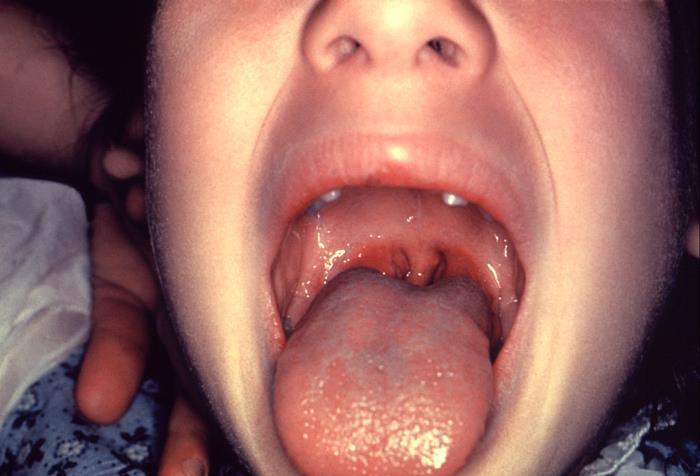Tonsillitis caused by Streptococcus pyogenes, a Group A β-hemolytic streptococcus (GAS), remains one of the most prevalent bacterial causes of acute pharyngotonsillitis. This gram-positive coccus is transmitted via respiratory droplets and exhibits high infectivity, particularly in crowded environments and among children aged 5–15 years. Upon colonization, it adheres to epithelial cells of the oropharynx using M protein and other surface adhesins, initiating a cascade of inflammatory responses.

Clinical Features of Streptococcal Tonsillitis
Streptococcal tonsillitis manifests abruptly, often with the following hallmark symptoms:
- Sudden onset of sore throat
- Painful swallowing (odynophagia)
- Fever >38.5°C (101.3°F)
- Tonsillar erythema and exudate
- Tender anterior cervical lymphadenopathy
- Headache and malaise
- Absence of cough (helps differentiate from viral etiology)
Additional Pediatric Symptoms:
- Abdominal pain
- Nausea or vomiting
- Scarlatiniform rash (in scarlet fever cases)
Transmission and Epidemiology
GAS tonsillitis is primarily transmitted via airborne droplets or direct contact with infected respiratory secretions. It displays peak incidence during late winter and early spring. The risk increases in shared environments such as schools, daycares, and military barracks.
Pathophysiological Mechanism
GAS employs virulence factors like M protein (resisting phagocytosis), streptolysins (cell destruction), and pyrogenic exotoxins (triggering fever and rash). These factors contribute to both local inflammation and potential systemic complications.
Diagnostic Evaluation
Clinical Criteria – Centor Score:
| Criterion | Points |
|---|---|
| Fever >38°C | 1 |
| Tonsillar exudates | 1 |
| Tender anterior cervical nodes | 1 |
| Absence of cough | 1 |
| Age 3–14 years | +1 |
| Age ≥45 years | -1 |
A score of ≥3 warrants microbiological confirmation.
Confirmatory Tests:
- Rapid Antigen Detection Test (RADT): High specificity, immediate results
- Throat Culture: Gold standard, results in 24–48 hours
- Polymerase Chain Reaction (PCR): Advanced detection, high sensitivity
Differential Diagnosis
| Condition | Distinctive Features |
|---|---|
| Viral pharyngitis | Cough, conjunctivitis, rhinorrhea |
| Infectious mononucleosis | Hepatosplenomegaly, atypical lymphocytes |
| Diphtheria | Gray pseudomembrane, neck swelling |
| Gonococcal pharyngitis | Sexually active individuals, minimal exudate |
Treatment and Management
First-Line Antibiotic Therapy:
- Penicillin V: 250 mg PO 2–3 times daily for 10 days (children), 500 mg BID (adults)
- Amoxicillin: 50 mg/kg/day divided BID for 10 days (max 1000 mg/day)
Alternative Regimens:
- Cephalexin: For non-anaphylactic penicillin allergy
- Azithromycin or Clindamycin: For true penicillin allergy
Supportive Care:
- Analgesics: Acetaminophen or ibuprofen
- Hydration and rest
- Saltwater gargles and throat lozenges
Potential Complications
Suppurative:
- Peritonsillar abscess (quinsy)
- Retropharyngeal abscess
- Otitis media
- Sinusitis
Non-suppurative (immune-mediated):
- Acute rheumatic fever
- Post-streptococcal glomerulonephritis
- Pediatric autoimmune neuropsychiatric disorders associated with streptococcal infections (PANDAS)
Prevention Strategies
- Avoid sharing utensils or drinks
- Prompt treatment of infected individuals
- Hand hygiene and respiratory etiquette
- Screening and treating asymptomatic carriers in outbreak settings
Prognosis and Follow-Up
With appropriate antibiotic therapy, symptoms usually resolve within 3–5 days. Early treatment reduces contagion duration and prevents serious complications like rheumatic heart disease. A follow-up is generally unnecessary unless symptoms persist or recur, suggesting complications or non-compliance.
Recurrent Streptococcal Tonsillitis and Surgical Intervention
Patients experiencing ≥7 episodes in 1 year, ≥5 episodes/year for 2 years, or ≥3/year for 3 years may benefit from tonsillectomy. This decision requires careful assessment of disease severity, impact on quality of life, and frequency of complications.
Frequently Asked Questions:
Q1: Is streptococcal tonsillitis contagious?
Yes, it spreads through respiratory droplets and close contact with an infected person.
Q2: How long is someone with strep throat contagious?
Without treatment, up to 2–3 weeks. With antibiotics, typically no longer contagious after 24 hours.
Q3: Can strep throat resolve without antibiotics?
Yes, but untreated cases risk serious complications like rheumatic fever.
Q4: What distinguishes strep throat from viral sore throat?
Strep lacks cough and cold symptoms and presents with fever, exudate, and tender lymph nodes.
Q5: When should a tonsillectomy be considered?
For patients with recurrent, severe episodes or complications despite adequate treatment.
Tonsillitis due to Streptococcus pyogenes is a clinically significant condition requiring prompt diagnosis and evidence-based treatment. Early intervention with antibiotics not only ensures symptomatic relief but also prevents severe systemic sequelae. Emphasizing accurate testing, adherence to therapy, and preventive measures is vital in curbing its transmission and recurrence.